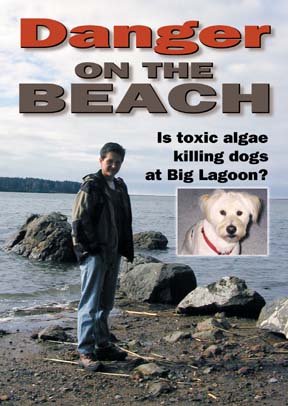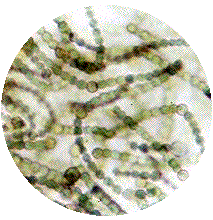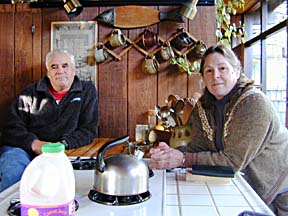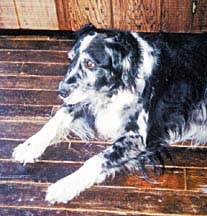|
 

story & photos by ARNO HOLSCHUH
HEATHER MULLER OF SACRAMENTO
loved her dog Ernest, a fluffy white 6-year old mutt, and Ernest
loved the outdoors. [in
above photo]
So when Muller left the confines
of the big city to visit the open spaces of Humboldt County,
she always took Ernest along. Muller normally camped at Patrick's
Point, but this year she decided to look for another spot --
for Ernest's sake. "They're not too dog-friendly at Patrick's
Point," she explained.
In late July she chose the county
campground on the shore of Big Lagoon and decided to do some
fishing. The clerk at a nearby tackle shop told her there was
a secluded beach on the north side of the lagoon where she might
have luck with steelhead.
When she arrived at the gravelly
beach, she found something strange in the water --foul-smelling,
blue-green foam close to shore. Muller, who described herself
as "totally paranoid" about the health of her pets,
asked two nearby windsurfers if the substance was harmful to
dogs.
"The lady said it was just
an algae bloom -- nothing to worry about," Muller said.
So she let Earnest loose to do what dogs do best -- frolic in
the water.
Later that night Ernest began
vomiting, but Muller wasn't worried. "In my experience,
that's what dogs do -- puke."
Twelve days and more than $1,000
in vet bills later, Ernest died. First he stopped eating, then
he stopped drinking water, then she took him to the vet where
he was diagnosed with liver failure. Shaking, dehydrated and
in pain, Ernest was made as comfortable as possible until Muller
finally made the most difficult decision a pet owner can: She
put him down.
Ernest's death -- and the deaths
of at least four other dogs in the county this year -- can almost
certainly be traced to a rare phenomenon called blue-green algae
poisoning. Actually a photosynthetic bacteria, blue-green algae
(or cyanobacteria) are present in many bodies of fresh or brackish
water. Normally they exist in such low concentrations that they
cannot be detected without laboratory equipment. But when certain
conditions are right, they experience an exponential growth in
population, reproducing until they form a layer of sticky, smelly
scum.
Even such a population explosion
-- called a bloom -- is not normally dangerous. Only certain
strains of the bacteria produce toxins, and then only when they
are decomposing.
It is impossible to prove beyond
a doubt that blue-green algae caused the dogs' deaths because
a conclusive tissue test does not exist. But a consensus is growing
-- among private veterinarians, state and county officials, and
the owners of the deceased dogs -- that it is by far the most
likely cause.
What has Muller and other dog
owners angry is not that the naturally occurring algae exists.
It is that neither county nor state officials put signs up after
Muller warned them that something was seriously wrong at Big
Lagoon.
Muller, a public relations professional,
spent a good part of what remained of her vacation crawling up
and down the chain of command in county parks, state parks and
the Department of Fish and Game. Throughout the month of August
she tried to get some agency to simply alert other dog owners
at the beach. She was repeatedly rebuffed. In the meantime, other
dogs were meeting the same fate as Ernest -- liver and kidney
failure, likely caused by the ingestion of blue-green algae.
Muller's first stop after Ernest
was diagnosed July 28, while he was still alive, was the campground.
She spoke with the camp host, who put her in contact with a county
parks ranger.
"I gave him a copy of a
toxicology report and he said he would take it to his boss,"
Muller said. The next day she received a note saying that state
and county parks, which share jurisdiction over Big Lagoon, had
decided to post the signs.
"Shortly thereafter, Ernest
died, and I went down to see if in fact the signs were up --
and they were not." When Muller called county parks she
was told that the county was going to wait for approval from
state parks so they could coordinate their actions.
State parks, in turn, went to
the state Department of Fish and Game for advice. Fish and Game,
Muller learned, had recommended against putting signs up.
"I called Fish and Game
and talked to a woman named Karen Kovacs. I asked her what the
deal was," Muller said.
"When we initially got
the call on this, it was so out of the blue I had never even
heard if it," said Kovacs, a senior biologist supervisor
with Fish and Game. Kovacs said after county parks related the
story to her, she contacted Humboldt State University scientists
and Fish and Game veterinarians. According to Kovacs, they said
there was no information to indicate that the blue-green algae
was likely to cause injury to wildlife.
"The question was, do we
have any proof? And at that time, there wasn't any," Kovacs
said. Given that warning signs might have negative side effects,
such as scaring away tourists, she suggested that warning signs
not be posted.
"Do we want to concern
people unnecessarily? There are a lot of people who recreate
up at Big Lagoon," she said.
In fact, Kovacs said, she has
yet to be convinced that blue-green algae was the cause of death.
"There is not enough there
so far to convince me that it is [blue-green algae poisoning],"
she said. "The only thing for sure is that [the deaths]
occurred. Is that enough to show there's a smoking gun called
blue-green algae in Big Lagoon? No."
But the most important thing
to realize is that the decision was never hers to make, Kovacs
added.
"I can't tell them what
to do," she explained, because Fish and Game does not have
jurisdiction over the beach. Kovacs only becomes involved if
wildlife is injured, and there has been no evidence that has
occurred.
"The Department of Fish
and Game is a resource agency for the state of California. What
purview do we have over domestic dogs?"
Kovacs' early August recommendation
may not have had the power of law, but it was enough to stop
the state and county parks officials from putting warning signs
up.
Bob Anderson, the state's supervising
ranger for Big Lagoon, said after he spoke with Fish and Game,
"I wasn't really sure what we had. We didn't really know
if this blue-green algae was really the cause or not."
Anderson asked his superiors
how to proceed. "We were told to monitor it and not put
any signs" unless it was clear that blue-green algae was
harming animals at Big Lagoon.
Of specific interest were wild
animals. "It was a matter of monitoring the area to see
if we found any [injured] wildlife and we never did."
Again the issue of jurisdiction
complicated matters.
"State parks owns quite
a bit of land around the lagoon but we don't own anything on
the water itself," Anderson said. "I believe that's
Fish and Game [jurisdiction]."
"If we had had some conclusive
evidence, that would have helped. We would have put the signs
up if we had known for sure."

What the state parks needed
was proof and proof was hard to come by. Because the toxin is
unidentifiable in tissue samples, you can never conclusively
say it has caused a dog's death. Evidence can only be collected
from the periphery -- the dog's symptoms, the weather and the
appearance of the substance. All of those seemed to point convincingly
to blue-green algae. But to a scientific mind, those factors
were just so much circumstantial evidence.
"I don't know that anyone
ever established that it was blue-green algae that caused those
dogs to die," said Frank Shaughnessy, who teaches biology
at HSU.
Shaughnessy said that while
there is enough evidence to make the blue-green algae poisoning
scenario plausible, there wasn't enough to reach a conclusion.
He looked at samples from Big Lagoon and found blue-green algae
present -- but even that was not conclusive.
"These organisms will `bloom'
and some of them are known to be toxic, yes. But there are a
whole bunch of strains that are quite beneficial to our environment,"
he said. Other strains, like spirulina, are even eaten by humans
as a health food.
There are some indicators that
this may be a strain that usually does not flourish in Big Lagoon.
The lagoon did not breach in the winter of 2000-2001, so the
normal exchange of salt water from the Pacific and fresh water
from the streams feeding the lagoon never took place. The lack
of breaching also meant that the outgoing steelhead run was trapped
in the lagoon, contributing an excess of nutrients to the water.
An excessively fresh, rich water
supply may have caused a strain of blue-green algae always present
in background levels to explode. Put another way, if there had
been a freshwater-friendly toxic strain, this year was its chance
to shine.
"That could be the correct
scenario," Shaughnessy said, but still doubts remain.
"The bacteria needs to
be looked at and identified all the way down to species and strain"
in order to reach a scientifically valid conclusion about its
potential danger.
However, outside the realm of
science, a different standard should apply, Shaughnessy added.
Signs should be posted "just to err on the side of being
cautious." And if there is a danger to dogs, there is a
potential danger to humans as well, however small.
"I would suggest that dogs
are vertebrates and so are we. We've got livers," he said.
Muller was becoming increasingly
frustrated trying to convince the authorities of the argument
to err on the side of safety. Then mysteriously, in the middle
of August, the bloom seemed to clear.
"Bob Anderson calls me
and leaves a message saying the bloom has cleared, they're not
going to be putting any signs up at this time, and they will
continue to visually monitor the water," Muller said. "That's
when I said to hell with it and went home."
What neither Muller nor the
parks administration knew was that the algae is very elusive;
visual monitoring is not enough to conclude the bloom has cleared.
Assuming blue-green algae had
caused the dogs' deaths, it would be almost impossible to tell
when the danger had abated, Shaughnessy said. "If the bloom
were completely gone, there wouldn't be a problem, true. But
I would be doubtful that the bloom was completely gone.
"What's probably happened,"
he said, "is the population number has dropped down to a
lower level so you don't see it or smell it when you walk along
the water." That means it could come back at any time.
What's more, the algae can drift
into coves and other hard-to-spot areas and form high concentrations
there. Sometimes particles will sink to the bottom, where they
are difficult to detect. "There can be hot spots,"
he explained.
The only way to tell conclusively
would be to take hundreds of water samples, each of which would
cost about $70 to process. And because no government agency was
even clearly responsible for the situation, there was no one
to pay for that testing.
 Maggy Herbelin and her husband,
Charlie [in photo at left]
had just returned from Japan when
their dog was poisoned at Big Lagoon Oct. 13. Charlie, an avid
windsurfer, was eager to get back onto the water with his best
buddy, an Australian shepherd-English setter mix named Wabi.
[in photo below right] Maggy Herbelin and her husband,
Charlie [in photo at left]
had just returned from Japan when
their dog was poisoned at Big Lagoon Oct. 13. Charlie, an avid
windsurfer, was eager to get back onto the water with his best
buddy, an Australian shepherd-English setter mix named Wabi.
[in photo below right]
"That evening, we went
out to dinner with some friends and Wabi threw up in the car,"
Herbelin said. "The next day she was off her feet and that
night she started throwing up blood." The couple took Wabi
to an emergency clinic, where the dog was rehydrated and diagnosed
with liver cancer.
The next day, their veterinarian
told them he was curious and wanted to send blood samples to
a lab for analysis. When the results came back later that day,
they confirmed that Wabi's liver had been seriously damaged.
By that time, the dog was dead.
"When I saw that report,
I said, `Let's do an autopsy,'" Herbelin said. "[The
vet] said OK, because a couple of weeks prior he had another
dog come in with the same symptoms." When the results came
back, they indicated Wabi had probably died of blue-green algae
poisoning.
 Herbelin was already on the
case. As chair of the Humboldt Bay Watershed Advisory Board,
she was familiar with water safety issues and wanted someone
to test the water at Big Lagoon. She sent samples to Shaughnessy,
who confirmed the presence of blue-green algae. Herbelin was already on the
case. As chair of the Humboldt Bay Watershed Advisory Board,
she was familiar with water safety issues and wanted someone
to test the water at Big Lagoon. She sent samples to Shaughnessy,
who confirmed the presence of blue-green algae.
"I called Fish and Game
that day, where I got a runaround," Herbelin said. "I
was told they had no interest in looking into the matter at all."
But shortly thereafter, someone
finally did develop an interest. Brent Whitener, who works with
the county Health Department's vector control unit, was at the
Big Lagoon county campground Oct. 22 checking out a possible
case of rabies when he heard about something odd.
"I was advised that the
campground host at the park had lost his dog. That's when I began
my investigation," he said.
His first stop was to call the
local veterinarians, from whom he was able to confirm that not
one but at least five dogs had died after swimming in the lagoon
-- and the blood test results all showed liver damage.
It was enough to convince Whitener.
"The people who owned the
dogs said the dogs didn't have an opportunity to eat poisonous
mushrooms. They seemed to swim in the lagoon, and since they
were water dogs they wanted to lick and groom themselves when
they got out, quite literally eating the algae."
Oct. 25, just three days after
Whitener first learned of the problem, the county public health
branch posted signs on the county beaches at Big Lagoon. Nov.
9 state park officials agreed to allow the county to post signs
at the state end of the lagoon -- where the poisonings were occurring
-- although they declined to post signs themselves.
![[text of warning sign] WARNING: BLUE GREEN ALGAE PRESENT IN BIG LAGOON Avoid contact with the water. Presence of blue green algae in Big Lagoon during this fall season can result in buildup of toxics in the water to dangerous levels. Small coves and inlets of the lagoon where the algae collect are especially prone to higher levels of these toxins. Children and pets in particular should avoid these areas, not ingest the water, or consume or handle the algae. Questions or comments? Please contact: Humboldt County Public Health Branch Environmental Health Division, 445-6215](cover1129-warningsign.jpg)
Why did five dogs have to die
in order for signs to be put up? The answer lies in a second,
larger question: Who is responsible for the welfare of domestic
animals?
It isn't public health, according
to Whitener.
"What we have here is a
veterinary health threat rather than a [human] public health
threat," he said. "The nature of blue-green algae is
to lay up on the shore with a bad smell and a pond-scum appearance."
Because of how distasteful the stuff looks and smells, humans
are not likely to ingest it.
The only reason Whitener suggested
posting signs was because of the severity of the situation. "We're
not dealing with an issue that would typically be public health.
We were so taken aback by the nature of this that we decided
to break from our normal profile and at least put up signs."
Pete Peterson, a state veterinarian
charged with monitoring livestock diseases, told the Journal
in an interview in Arcata last week, "Blue-green algae
is a grey area of public safety." He didn't initially get
involved because no livestock was affected. It was frustrating
for him, he said, because as the summer turned into autumn, he
was hearing from more private small-animal veterinarians that
something was very wrong.
"We had what we call a
cluster -- an unusual pattern or number of deaths," Peterson
said. Trained to spot clusters in livestock, Peterson knew one
when he saw it with the dogs. "Same locale, same circumstances,
same history, same clinical pathology."
"Once you have a cluster,
it's an indication something is legitimately there."
But it didn't matter -- there
was no livestock involved. Peterson may have been concerned,
but he wasn't responsible to do something.
"I hope [the state] would
have someone to take care of concerns like this," said Jeri
Oliphant, the veterinarian who treated Ernest. "If there
is a toxin making pets ill, especially deathly ill, then someone
should take responsibility for that.
"Was this a collapse of
the system? I don't think so. They don't have a system."
IN
THE NEWS | ARTS ALIVE! | CALENDAR
Comments? E-mail the Journal: ncjour@northcoast.com

© Copyright 2001, North Coast Journal,
Inc.
|